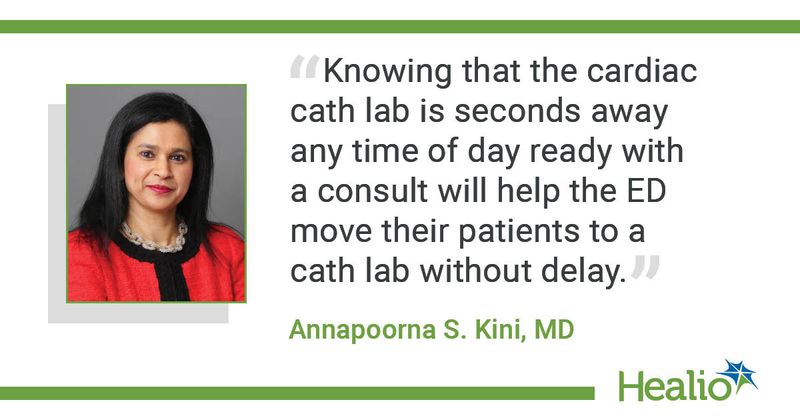New app streamlines care for patients needing transfer for STEMI
Not all centers have catheterization laboratories to treat patients with STEMI, so those centers need to have a well-functioning transfer process in place when such a patient arrives.
Mount Sinai Health System is using a new application to streamline the transfer process.

Each year, approximately 150 patients present with STEMI to Mount Sinai Queens, which does not have a cath lab and must transfer the patients to The Mount Sinai Hospital’s Cardiac Catheterization Laboratory in Manhattan, a journey that is 6 miles long but usually fraught with heavy traffic.
The app, called STEMIcathAID, is opened by an ED physician at Mount Sinai Queens, who uploads the patient’s ECG to it. The app then alerts the on-call interventional cardiologist at The Mount Sinai Hospital and the transfer center. If the on-call interventional cardiologist decides a cath lab procedure is needed, the app alerts the on-call cath lab team, who log in and conduct a call or video chat with the team in Queens. As the patient is being transferred, the cath lab team can track the progress of the ambulance through the app and have the cath lab prepared by the time the patient arrives, reducing delays to procedure time.
Healio spoke with Annapoorna S. Kini, MD, director of The Mount Sinai Hospital’s cath lab, who led the team that designed the app.
Healio: What are some of the biggest challenges of providing proper care for patients with STEMI?
Kini: With multiple teams involved, the cardiac cath lab, the ED and transfer services, there are a lot of opportunities for the introduction of system delays. These patients have 120 minutes to meet the criteria for a successful transfer and every minute counts in a busy city.
Healio: What prompted the idea for the development of this app?
Kini: Years of experience in the cardiac cath lab with STEMI patients made it clear it was time to improve the way we handle these cases with fast communication between the various involved providers.
Healio: How does this differ from other platforms?
Kini: STEMIcathAID was developed from the ground up by cardiologists with the collaboration of emergency medicine and transfer services. It was made to perfectly fit the needs of these transfers.
Healio: Are there plans to study the efficacy of this app?
Kini: Once we have collected a sizable cohort, we plan to study all of the available metrics, about 80 potentially extractable data points, to optimize our STEMI care and publish our findings.
Healio: Are there plans to use this app in other locations?
Kini: Once the Mount Sinai Hospital-Mount Sinai Queens pilot enters a more mature phase, we plan to roll this out system-wide.
Healio: Are there plans to use this app for other urgent conditions (such as stroke)?
Kini: Absolutely, although it will require some customization to fit those pathways. The core ability to improve communication and ability to alert the correct health care members is universally helpful for many urgent conditions.
Healio: How might this platform transform STEMI care?
Kini: Standardizing systemwide STEMI care will be very helpful. Knowing that the cardiac cath lab is seconds away any time of day ready with a consult will help the ED move their patients to a cath lab without delay.
Healio: Is there anything else you’d like to mention?
Kini: Our goal is to get this app into the hands of EMTs to get STEMI patients to the cath lab as soon as possible.
Reference:
For more information:
Annapoorna S. Kini, MD, can be reached at annapoorna.kini@mountsinai.org.
